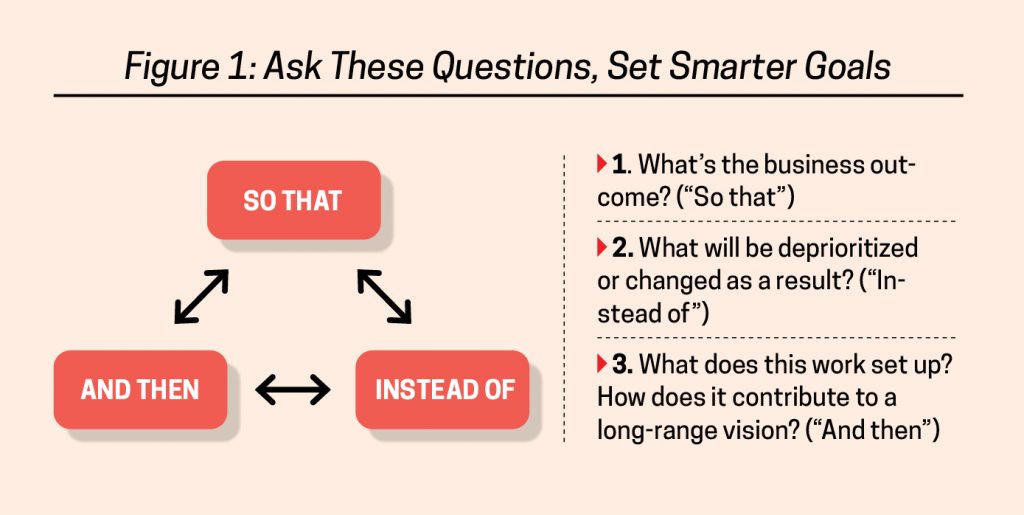This ubiquitous goal-setting tool isn’t all it’s cracked up to be. Here’s a smarter way to enable strategic impact.
By Anne Davis Gotte and Kevin D. Wilde
No doubt you’re familiar with S.M.A.R.T., the oft-cited standard for the development and audit of high-quality goals: specific, measurable, agreed-upon, reachable, and time-bound. It’s hard to argue with the value of discipline and clarity in goal setting. But as practitioners, we’ve experienced the shortcomings of adhering strictly to this traditional approach.
In a way, you could say that working with S.M.A.R.T. has dumbed us down. And that’s why we’re suggesting a new framework.
Goal setting is perhaps the most critical element of performance management. It’s essential in driving alignment, prioritizing focus, and enabling accountability. Yet the practice is often the most poorly managed step in a performance management process. This is a problem.
Sign up for the monthly TalentQ Newsletter, an essential roundup of news and insights that will help you make critical talent decisions.
S.M.A.R.T. may fall short because in too many cases, you can pass a “S.M.A.R.T. audit” of your well-written goals and still fail to deliver the most important impact for your organization. Talent leaders with an overreliance on S.M.A.R.T run the risk of developing overly tactical and un-prioritized strategies. In other words, you may get too much of the wrong stuff done and fail to create capacity for your teams to impact what matters most.
So how do we reframe S.M.A.R.T.? While the acronym is still a useful lens for setting direction, we think it’s far more critical to start by focusing on business contribution, holistic prioritization, and broader perspective. People with strategically aligned goals should be able to answer three interrelated questions with ease (see Figure 1).
Figure 1: Ask These Questions, Set Smarter Goals

1. What’s the business outcome?
The business outcome—the “so that”—forces consideration about impact and not just activity. As your teams become accustomed to this idea, they’ll naturally identify what attaining any specific goal will achieve for the business.
For example, “successfully roll out 12 digital sales training modules in the first quarter” might be a fine start to a goal for a training and development professional. But it may also be completely inadequate. To find out for sure, ask, “So that what happens? So that sales quota attainment will increase 10 percent? Or new sales representatives will contribute 50 percent more to top-line growth in the year? Or so that a critical new product introduction will reach benchmark market share?”
Being clear on the impact ensures that you’re working on the right stuff, and helps you do the right stuff in the right way. In this example, the content of the training could vary significantly depending on desired outcome. Furthermore, clear “so that” thinking often creates more meaningful targets for measurement and dashboard reporting.
If you’re unable to credibly link goals to high-priority business outcomes, your goals may be S.M.A.R.T.—but they aren’t smart. And since most studies on the topic would indicate that working adults aren’t looking for less meaning or more busy work in their jobs, we recommend that before you rubber-stamp a S.M.A.R.T. goal, press pause.
Partner with your leaders to reconsider your business needs and set goals to contribute to those needs in meaningful and important ways. In some cases, talent work makes a direct, driving contribution to the business. In others, it may be one of several strategies contributing to the desired business outcome. Either way is fine, so long as you’re clear with your stakeholders.
In driving for a clear link to impact, you also have an opportunity to debunk myths, revisit practices that are time-consuming for managers and HR alike, and simplify. Focusing on the “so that” helps you not only do the work that matters, but it provides license to get at the most essential parts of the work and drive efficiency. Taking this step may be a bit more work than the typical S.M.A.R.T. step of getting agreement, but it’s well worth the effort.
However, “so that engagement increases” misses the point of this exercise. The employee experience and overall engagement of your workforce is important, but engagement is not a business outcome. While our work as talent leaders must focus on building a high-performing workforce, we have an opportunity to be more precise.
2. What will be deprioritized?
On its own, S.M.A.R.T. never calls for trade-offs. We don’t explore questions about organizational muscle and resourcing, change management, and basic capacity. If all you need to do to deem a goal worthy of time and energy is work through a S.M.A.R.T audit, tasks and activities can proliferate unchecked.
In this scenario, “so that” sounds something like, “We burdened ourselves with as much new programming, project management, and external benchmarking so that we could prove to the business that we add value as strategic partners. And in our efforts to always add more value, we did exactly the opposite.”
In other words, S.M.A.R.T. goals might keep you busy, but may not help you achieve the biggest impact needed. If everything looks equal in value, you’ll most likely under-resource the biggest opportunities and waste time on things that don’t matter as much.
“Instead of” helps you to push goal-setting discussions to include decisions about what gets cut, delayed, or reduced. It asks what will be deprioritized so the choice to do something well is supported by intentionally choosing what not to do.
The best “instead of” candidates are often legacy programs that may still be liked but have lost some of the high-value payoff they once held. Organizational loyalty and fluency protect these programs in some cases well beyond their useful shelf life. If they aren’t addressed, they take precious capacity away from more pressing opportunities.
In our example of the new digital sales training roll-out, a team might answer the “instead of” challenge by dropping a legacy classroom program that has seen declining interest and postpone a new negotiations program until later in the year.
“Instead of” requires teams to work through discomfort and push on functional peers and line leaders alike. Change is difficult; as you seek to jettison familiar offerings to forge into new spaces, your team and clients may push back with discomfort. Here, your work on “so that” will be a critical touchstone.
Making sure everyone is aligned around what is most needed for the future allows for an objective review of the work at hand. But while that clarity is necessary, it isn’t sufficient to drive effective “instead of” dialogues. You must also demonstrate conviction and courage and instill that ethos in your teams.
Bigger impact and bolder decisions rely in part on our ability as leaders to own the outcomes and influence others on the path forward. As a senior HR leader once told us, “Drive-thru window HR is not our goal.” That’s why “instead of” is about clarifying the value that your team will deliver and aligning up front with your clients on how it comes to life.
Finally, if you’re struggling to drop anything despite careful review and candid discussions, pause and take a moment to reevaluate your “so that” work. Were you sufficiently strong and compelling? Were you clear? In a way, your “instead of” tests the robustness of your “so that.” And that’s a good thing.
3. What does this work set up?
S.M.A.R.T. goals are bite-sized and time-bound—a useful element of their design. However, as you seek to connect goals to larger strategic initiatives and draw clear links to business outcomes, S.M.A.R.T. thinking is often limited to close-in and narrow work.
Big companies are complex ecosystems, and there are rarely just a few S.M.A.R.T. goals at play. In ensuring a real impact, sequencing matters-and what happens before, during, and after the work of a S.M.A.R.T. goal are vital considerations.
Before you finish your strategic planning and goal-setting work, consider the effort necessary on the other side of goal attainment. You’ll need reinforcement, follow-up support, and adjustments to keep up with the requirements of continual change.
It’s common for talent initiatives to make an impressive launch and fade away or never reach their true potential. S.M.A.R.T. alone will keep you focused on shorter-term work—not building strong enough plans for what’s needed for sustained success.
“And then” requires the ability to pause and take a strategic perspective of future conditions and consequences. In lieu of staging one-act plays, reframing goal setting with “and then” thinking produces a series of acts that build stronger follow-through and impact.

For example, the sales training goal might require updates for new product changes, adjustments to improve effectiveness, and a second series of reinforcements built into the CRM. The lesson: Thinking about what comes after you achieve your immediate goal is the mark of true strategic talent management.
Working through our new digital sales training example, a strategic follow-up act might be to establish a new baseline of sales capabilities with an integrated performance management assessment for further training. You might also begin a series of frontline sales leadership coaching to support the new sales approach.
Each of these S.M.A.R.T reframe phrases provide a better strategic lens to your goal setting, and all three will enable your planned efforts to have optimal impact. Now that’s smart.
Anne Davis Gotte is the senior vice president of global talent at Ecolab. She is the former director of global talent management at General Mills.
Kevin D. Wilde is the executive leadership fellow at the University of Minnesota Carlson School of Business. He is the former vice president of organization and effectiveness and chief learning officer at General Mills.


